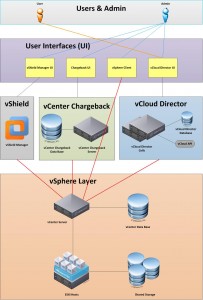vCloud Building Blocks
VMware’s vCloud Director requires a few components put together in order to function. This is a high level showing how the basic components work together.
The vSphere Layer
VMware vSphere is the foundation layer that the vCloud is built on. It is basically the “invisible” engine that vCloud uses to excute all tasks.
vShield Manager
vShield Manager (VSM) is the management interface for all yhe vShield products. VSM creates secure network isolation for organizations within vCloud. It also provides firewalls, VPNs, NAT and routing services for those organisations. VSM is bundled as a virtual appliance and deploys as a virtual machine.
vCenter Chargeback
vCenter Chargeback is used to measure and report on costs associated with the consumption of the virtualized infrastructure. The components of vCenter Chargeback include the server and its database. It is sold as a stand alone that integrates with vCloud Director.
VMware vCloud Director
VMware vCloud Director provides the interface to allow service providers/organisations to supply vSphere resources through a web-browser to end users.. The physical layer is masked from end users. Users use the vCloud self service portal to execute their tasks utilizing vSphere behind the scenes.
vCloud API
The vCloud API is an open, RESTful interface to the vCloud. It enables deploying and managing virtualized workloads in private and public clouds. The vCloud API enables the upload, download, deployment and operation of vApps, networks and “virtual data centers”.
VMware vCloud Director Database
Like vCenter, vCloud Director also needs a shared database where all configuration is stored. Also like the vCenter, if vCloud loses its Data Base, you lose the ability to manage the cloud infrastructure. Although, the workloads will be unaffected. Since the data base is critical to the operation of vCloud Director, it should be should be clustered or a hot standby is provisioned.
vCloud Director Cell
A vCloud Director cell runs the vCloud Director software on a single server. Users requests go through vCloud Director Cells via the user interface.
To provide redundancy, multiple cells are clustered together. A load balancer is used to distribute traffic between the clustered cells.
This is a high level view of vCloud and I hope in further posts to dive in deeper into each component.
Thanks for reading
Nick






